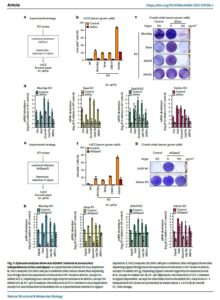 Nature Structural & Molecular Biology (2023). Nikhil Gupta, Lounis Yakhou, Julien Richard Albert, Anaelle Azogui, Laure Ferry, Olivier Kirsh, Fumihito Miura, Sarah Battault, Kosuke Yamaguchi, Marthe Laisné, Cécilia Domrane, Frédéric Bonhomme, Arpita Sarkar, Marine Delagrange, Bertrand Ducos, Gael Cristofari, Takashi Ito, Maxim V. C. Greenberg & Pierre-Antoine Defossez.
Nature Structural & Molecular Biology (2023). Nikhil Gupta, Lounis Yakhou, Julien Richard Albert, Anaelle Azogui, Laure Ferry, Olivier Kirsh, Fumihito Miura, Sarah Battault, Kosuke Yamaguchi, Marthe Laisné, Cécilia Domrane, Frédéric Bonhomme, Arpita Sarkar, Marine Delagrange, Bertrand Ducos, Gael Cristofari, Takashi Ito, Maxim V. C. Greenberg & Pierre-Antoine Defossez.
https://doi.org/10.1038/s41594-023-01038-z
Résumé
In mammals, only the zygote and blastomeres of the early embryo are totipotent. This totipotency is mirrored in vitro by mouse ‘2-cell-like cells’ (2CLCs), which appear at low frequency in cultures of embryonic stem cells (ESCs). Because totipotency is not completely understood, we carried out a genome-wide CRISPR knockout screen in mouse ESCs, searching for mutants that reactivate the expression of Dazl, a gene expressed in 2CLCs. Here we report the identification of four mutants that reactivate Dazl and a broader 2-cell-like signature: the E3 ubiquitin ligase adaptor SPOP, the Zinc-Finger transcription factor ZBTB14, MCM3AP, a component of the RNA processing complex TREX-2, and the lysine demethylase KDM5C. All four factors function upstream of DPPA2 and DUX, but not via p53. In addition, SPOP binds DPPA2, and KDM5C interacts with ncPRC1.6 and inhibits 2CLC gene expression in a catalytic-independent manner. These results extend our knowledge of totipotency, a key phase of organismal life.